Almost 20 years of development
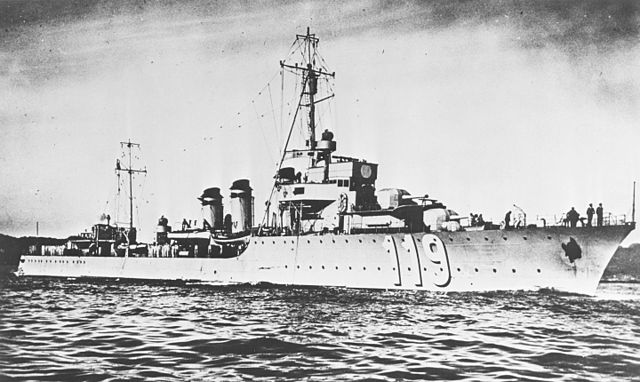
French Destroyer Frondeur of the L’Adroit-class – Official U.S. Navy photo NH 55990 from the U.S. Navy Naval History and Heritage Command
Almost 20 years of development: From the 1920s mass-produced “three-pipers” to the 40 knots, super-destroyers of the Mogador class, destroyer development in France went a long way. The first were initiated in the 1922 programme, following the Washington treaty. In fact all limitations other than qualitative for cuisers were dropped, as well as any limitations for destroyers. Admiralties could start with a blank page, and not surprisingly choose to stick with the Royal Navy concept of standard models and destroyer leaders. This led to the late 1930s classes of “super-destroyers”, of the Mogador class, almost light cruisers size.
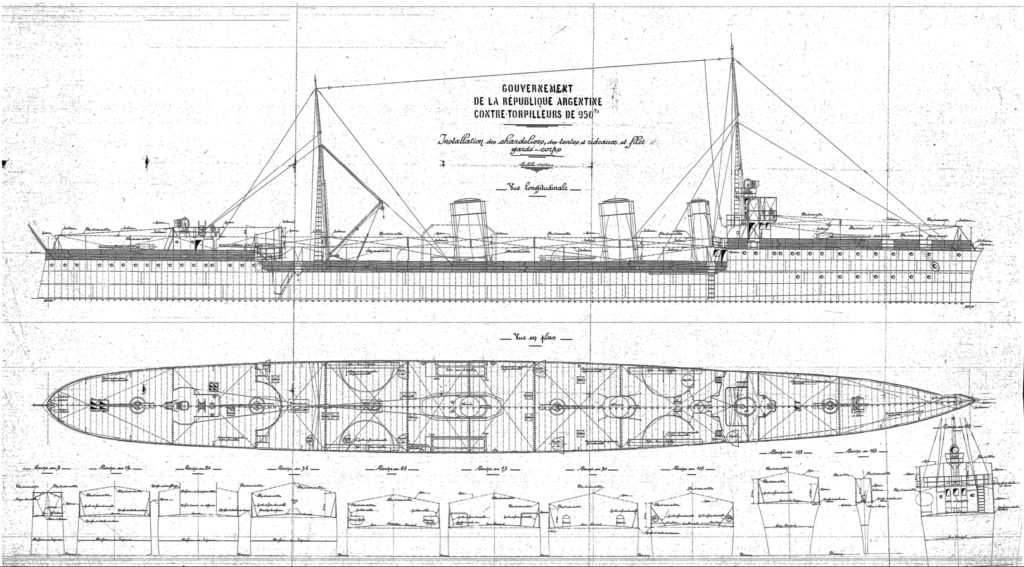
For reference, 1911 Aventurier class ex-Argentine DD design.
France was the only country to operate only interwar-built destroyers at the outbreak of war. All the prewar models has been discarded and since shipbuilding has been suspended during the war, models that were delivered late were of prewar initial design, and discarded too, bringing a few lessons. Italy and UK by comparison, still had dozens of ww1 and pre-ww1 era destroyers in service.

Blueprint of the Bisson class of 1912 (HD), retreived from Marine Nationale plans archives

Blueprint of the 1924 Bourrasque, for comparison
Early references: WW1-era DDs
The first series were already much larger than WW1 models. For memory the last French DD was started prewar, but launched in 1921 and completed in 1923, named Enseigne Gabolde. She was experimental, 950 tons fully loaded, with four funnels, a raised forecastle, 26,000 hp for 33 knots with Parsons turbines. Also in 1911, were started four Argentinian DD at Chantiers de Bretagne Nyd, Nantes, requisitioned in August 1914 and completed in 1917-18. At 1250 tons this Aventurier class was much larger, and was fitted with a unusual fore and aft forecastle. They participated in the baltic sea campaign in support to the “white” Russians.
Two would receive new boilers and did serve for some time in the French Navy. Aventurier was broken up in 1940. Another reference was Japanese: The twelve Kaba type destroyers of the “colonial people” class, launched in 1917, built in a record 7 month. They all served in the Mediterranean. They had a small displacement at 682 tons but had a powerful armament, with a 4.7 in main gun (120 mm), the rest being anti-TB artillery of small caliber. They were not very fast (28 knots) but had a good range for their size.
War reparation destroyers
Another topic that was full of references for early interwar naval design, was to obtain many ex-German destroyers in 1920, following the Versailles treaty application. The only exception was the Dukla, of the excellent Austro-Hungarian Tatra class. These were the V67 and V125, S131 (4), H145 (2) and S113 renamed Matelot Leblanc, Pierre Durant, Buino, Chastang, Vesco, Mazaré, Deligny, Rageot de la Touche, Marcel delage and Amiral Senes. All were broken up in 1933-35.
Bourrasque class (1924)
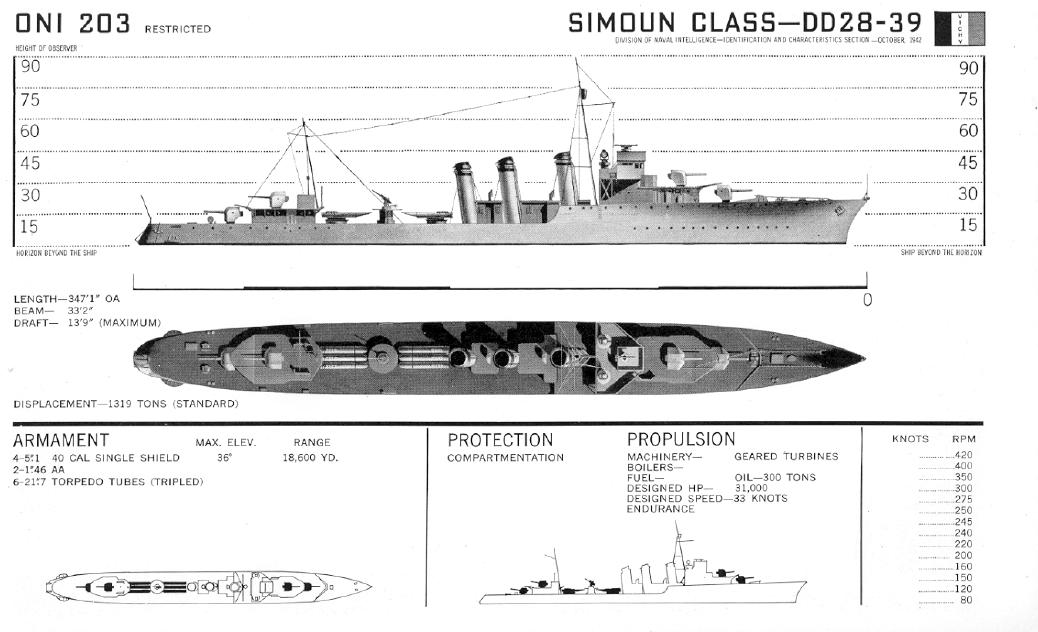
Bourrasque class Simoun – USN Recoignition plates (ONI) 1942
Destroyers of the Bourrasque class succeeded to the 850 tons series of 1912-15, and were called and collectively known as the “1500 tons”. They corresponded to the new standards of the time, developed on the basis of the large German destroyers like the E101 or last British, American, Japanese and Russian ships.
They were equipped with the new 130 mm model 1919 mounts. 12 ships total (Typhoon, Simoun, Thunderstorm, Tramontane, Hurricane, Cyclone, Storm, Mistral, Tornado, Gale, Sirocco, Trombe), were started in 1923, launched in 1924- 25 and completed in 1925-26. Officially referred to as “fleet torpedo boats”, they retained this generic designation of “destroyers”, this time with real ocean-going capabilities (especially for the Atlantic and the North Sea).
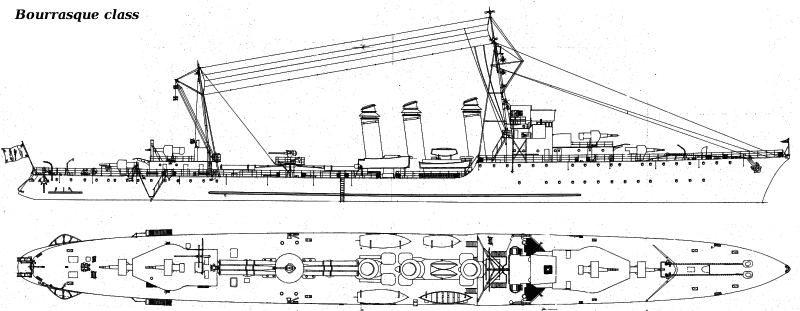
Blueprint of Bourrasque class – Unknown src – From Musee de la Marine original plans
In sea trials, their machines proved to be relatively unreliable, the best speeds reached with forced heat (34.5 knots) were never approached in service. Their main artillery, derived from an artillery model for the army, remained rather slow (four shots per minute). Their initial AA artillery was also weak, with a single 75mm AA gun and two 8mm machine guns. This AAA was reinforced in 1933-35. For submarine warfare and convoy escort, two ASW grenade launchers were also added with two stern racks of 10 grenade each. They had no Asdic in 1939. Their range was 2150 nautical miles at 14 knots.
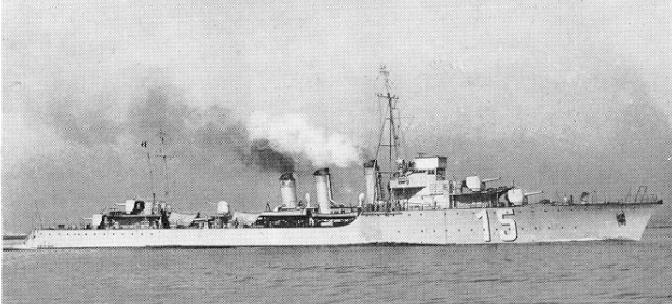
Destroyer Ouragan in 1939 – ONI203 booklet for identification of ships of the French Navy (cc)
These destroyers suffered a fate similar to that of the rest of the French fleet: Two were captured at Plymouth (Catapult operation) and later integrated into the Free French Navy, three were lost at Dunkirk in May 1940, another was scuttled on June 18 for avoid capture, three would be lost in November 1942 during Operation Torch (one scuttled, one sunk by US units). Units still in service rom 1942 had a 25mm gun and two additional 13.2mm AA machine guns in place of their TT rear bank, and some lost their third 130mm gun. The ships assigned to the FNFL in 1943 had in addition one 40mm gun and three 20mm AA of the American Oerlikon model and additional ASW launchers, as well as an ASDIC. The 5 survivors will be reformed and demolished in 1950.

Destroyer Cyclone DD blueprint – Musee de la Marine
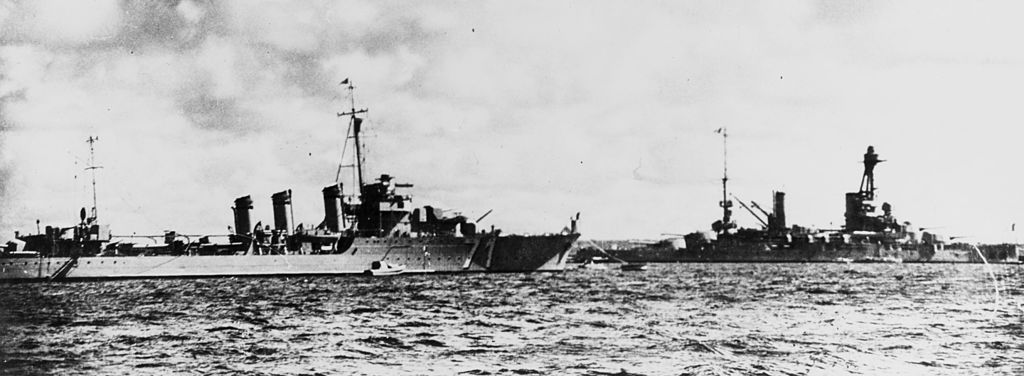
Destroyer Le Mars moored to a buoy circa 1939 – Official U.S. Navy photo NH 88975 from the U.S. Navy Naval History and Heritage Command (cc)
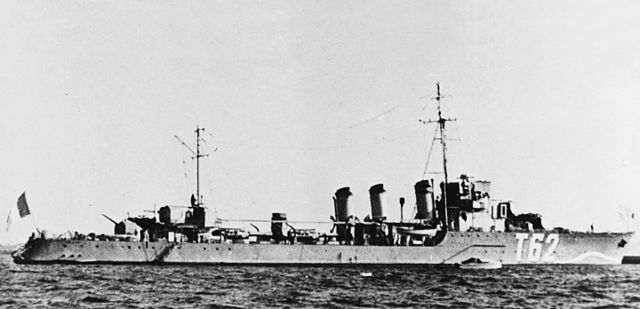
French Destroyer Sciroco – ONI203 booklet for identification of ships of the French Navy (cc)
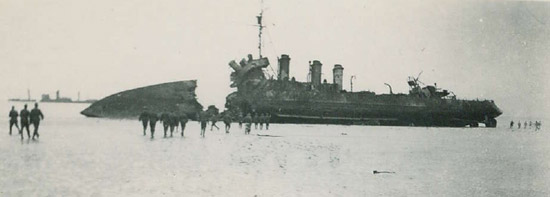
L’Adroit stranded at Dunkirk, Collection Wilfried Langry src
Specifications
Displacement: 1298 t. standard – 1970 t. Full Load
Dimensions: 106 m long, 9.64 m wide, 4.30 m draft.
Propulsion: 2 propellers, 2 Parsons turbines, 3 loire boilers, 31,000 hp. Maximum operational speed 33 knots.
Armour: 20 mm pieces under masks
Armament: 4 pieces of 130 mm model 1919, 2×37 mm AA, 4×8 mm AA, 6 TLT 550 mm (2×3).
Crew: 145

Illustration of the Bourrasque (“Gale”) in May 1940 during Operation Dynamo – Dunkirk.
L’Adroit class (1926)
This second series of standard destroyers called “1500 tons”, including 14 ships, started in 1925-28 and launched in 1926 to 1929, into service between 1928 and 1931. They took back the whole concept of high seas TBs of higher dimensions and tonnage, and more powerful machines improving their cruising speed, and improve reliability moreover. With a full load tonnage of 2000 tons, they were no longer really “1500 tons”… Nonetheless, they gave satisfaction, except for their limited range.
Their AAA was increased during the war: For the Vichy ships, a 75 mm gun and two 13.2 mm HMGs instead of the rear TT bank, then for the survivors serving under the FNFL, a 40 mm Bofors and three 20 mm Oerlikon, as well as ASW grenades in racks and launchers, and ASDIC.
Operational career:
Railleuse (“Scoundrel”) was the first French destroyer lost, March 24, 1940, destroyed by an accidental torpedo explosion in Casablanca. The Adroit was sunk by He-111 bombers May 21, 1940, off Dunkirk, but her crew managed to reach the beach, integrated 1st Division unit and continued fighting until the city fell. The Thunderer was sunk in similar circumstances, but with more casualties, on June 1, 1940. The Basque, Forbin and Fortuné were part of the French squadron of Alexandria, and were disarmed by the British on June 22, 1940 after the French capitulation.
They were later rearmed under the banner of the Free French Navy in December 1943, and received on this occasion an additional AAA. The Boulonnais, Brest, Brestois, Fougueux and frondeur were all sunk by Allied ships off Casablanca, as part of Operation Torch. Alcyon survived the attack and joined the Allies.

Illustration of the Brestois in nov. 1942 at Toulon.
Chacal class (1924)
Chacal class destroyers, also known as the Jaguar class, were the first “flotilla leaders” designed in France. They were much heavier than average. These “squadron leaders” had been designed to led squadrons of contemporary “Bourrasque” destroyers, but were armed with an longer range 130 mm guns and could sustain 35 knots, their range also being greater, as well as their AA artillery (at the time).
The Jaguar, Lynx, Jackal, Tiger, Leopard and Panther, were identified by their three raked funnels, and their stern was cut for launching ASW “Deep-charges” (16 in reserve), as well as 4 side ASW mortars launcher with 30 refills. Their 130 mm guns of the 1919 model had good range and precision but a low rate of fire with 5 bursts per minute. In September 1939, an ASDIC was added, their AA was revised, a platform added including 8 13.2 mm HMGs in two quadruple mounts in place of their central cannon.
Operational career:
During the conflict, Jaguar was torpedoed by two German S-Bootes in front of Dunkirk. Jackal was destroyed by Stukas in Boulogne the following day. Lynx was scuttled at Toulon in November 1942 and was deemed irretrievable. On the other hand, the Tiger and Panther, also scuttled, but in less serious state, were salvaged, upgraded and ceded by the Germans to the Italians, then briefly integrated into the Regia marina under the name of FR22 and FR23.
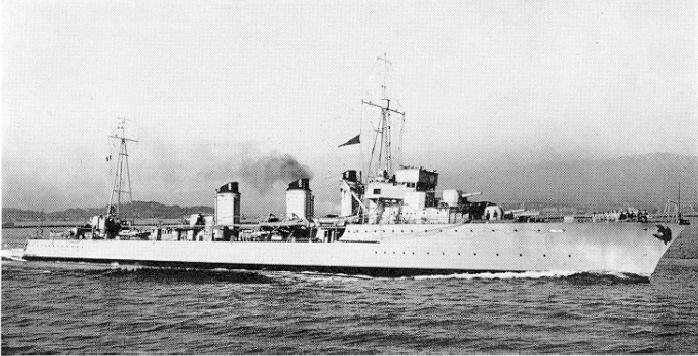
Chacal full speed ahead in hard turn -ONI203 booklet for identification of ships of the French Navy -PD (cc)
The FR23 returned to the French Navy and passed to the FNFL to the Italian capitulation in 1943. The FR22 was scuttled at La Spezia during the same Italian surrender. Rearmed, the FR23 participated in the rest of the conflict and was demolished in 1954. The Leopard went to the FNFL in 1942, and was reworked, with an additional fuel reserve added as well as additional AAA (American standards) for service in the Mediterranean. She was sunk off Tobruk in April 1943.
Specifications
Displacement: 2126 t. standard – 3050 t. Full Load
Dimensions: 126.8 m long, 11.32 m wide, 4.10 m draft.
Propulsion: 2 propellers, 2 turbines, 5 Guyeau boilers, 50,000 hp. Maximum operational speed 35 knots.
Armour: 20 mm pieces under masks
Armament: 5 pieces of 130 mm model 1919, 2×75 mm AA, 2×37 mm AA, 2×13.2 mm AA, 6 TLT 550 mm (2×3).
Crew: 195

Author’s illustration of the Jackal operating in Dunkirk in June 1940 (Operation Dynamo).
Guepard class (1927)
These six ships, Guepard (Cheetah), Valmy, Verdun, Vauban, Lion and and Bison followed quite closely the Jackal of the first series (1923-24). But the latter, who had proceeded to their tests in 1924-25 had learned lessons from their defects, integrated in the plans of the serie. They were therefore launched in 1928-30 and completed in 1929-31.

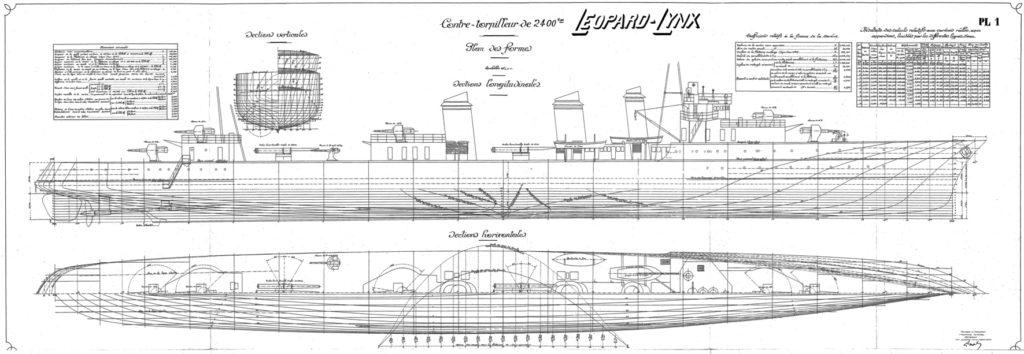
Blueprints of the Jaguar and Leopard classes – Archives Musee de la Marine
Design
They took over most of the former superstructure and artillery arrangements, but with a longer and wider hull, a displacement raising from 2126 to 2436 tons as standard. Their guns were of a new model (140 mm against 130 mm), firing 40 kgs shells, But with a still rather slow rate of fire (four to five rounds/minutes). In addition, their telemetry stations were able to be effective in all weathers but had a greatly reduced practical range. Their 37 mm model 1925 guns had a firing rate of 30 rounds per minute, and their ASW defense consisted of four Thornycroft mortars and two 24-grenade racks at the stern, integrated into the hull on dedicated rails.
Good steamers, these ships reached 35.5 knots, a half knot more than the Jackal. They could even reach and sustain 40 knots at half load. They were easily distinguished by their four heavenly spaced funnels, classic profile of French destroyers leaders. In 1940, it was decided to add a 25 mm AA guns and height 13.2 mm heavy machine guns in twin mounts.

Destroyer Guepard -ONI203 booklet for identification of ships of the French Navy -PD (cc)
Operational career:
Their long operational career was not the most glorious: The Bison was sunk in operations in Norway on March 3, 1940 by the Luftwaffe, and the other five, having been based in Mediterranean were repatriated in Toulon and scuttled on November 27, 1942. The Guepard, Valmy and Lion were bailed out and only the last two were repaired in time to be incorporated into the Regia Marina as the Fr24 and 21. The first was sunk in 1945 at Genes, after being scuttled with armistice, recovered by the Germans and reused for some time, and the second at La Spezia in September 1943. The Guepard hull was sunk in the harbor of Toulon on March 11, 1944 by an allied raid.
Specifications
Displacement: 2436 t. standard – 3200 t. Full Load
Dimensions: 130.2 m long, 11.70 m wide, 4.70 m draft.
propulsion: 2 propellers, 2 Parsons turbines, 4 Yarrow boilers, 64,000 hp. Maximum operating speed 35.5 knots.
Armour: 20 mm pieces under masks
Armament: 5 pieces of 138 mm model 1924, 4×37 mm AA, 4×13.2 mm AA, 6 TLT 550 mm (2×3).
Crew: 230

Illustration of the Guepard in 1940
Plans: http://dreadnoughtproject.org/French%20Warship%20Plans/Jaguar_EtAl_1923/
Aigle class (1930)
Built between 1927-28 and 1929-30, these 6 squadrons of squadrons were named birds of prey (Aigle, Gerfaut, Albatros, Vautour, Epervier and Milan) succeeding the Guepard. Very close, they still have new model 1927 semi-automatic guns, and implemented the first stereo rangefinders. In addition, they are able to reach 42 knots through improved booster boilers, deserving their names as “sea raptors”. The Sparrowhawk and the Milan also had a modified propulsion system displaying 68,000 hp, with 7 torpedo tubes in two double flank banks and one triple axial. They all received in 1940 a 25 mm AA gun and four 13.2 mm machine guns (one 37 mm gun and six double carriage guns for the Gerfaud).

Destroyer Milan in 1936 -ONI203 booklet for identification of ships of the French Navy -PD (cc)
Operational career:
The Aigle, Vautour and Gerfaut were scuttled in Toulon in November 1942 during German operation “Lila” (they were subsequently salvaged by the Axis, but an allied raid in 1943 destroyed them for good), the other three were in Casablanca during Operation Torch, and were ordered to sail and attack the Allied landing fleet. They were intercepted en route: Milan was sunk on November 8, and the Sparrowhawk on the 9th. The Albatross, badly damaged in the harbor, was judged recoverable, salvaged and repaired, and later integrated to the FNFL as a training ship until 1950. She ended his career as a pontoon in 1959.
Specifications
Displacement: 2440 t. standard – 3410 t. Full Load
Dimensions: 128.5 m long, 11.80 m wide, 5 m draft.
Propulsion: 2 propellers, 2 Rake turbines, 4 Yarrow / Penhöet boilers, 64,000 hp. Maximum operational speed 36 knots.
Armour: 20 mm pieces under masks
Armament: 5 pieces of 138 mm model 1927, 4×37 mm AA (2×2), 4×13.2 mm AA (2×2), 6 TLT 550 mm (2×3).
Crew: 230

Illustration of the Milan, 1940
Vauquelin class (1931)
These six ships, Vauquelin, Cassard, Maillé-Brezé, Kersaint, Tartu and and Chevalier Paul succeeded the Aigle serie. They were virtually copies, except for the adoption of a bow with a slightly different design. Their stern was adapted to minelaying. They were fast and good steamers, the Cassard managing to sustain 43 knots in trials. Operational in 1932-34, they were the best and last of the “2400 tons”, also called “four pipers”. The Cassard received a supplement of AA artillery in 1940, with four 37 mm guns in twin mounts, 1 of 25 mm and four 13.2 mm MG mounts. The other ships received 8 machine guns and a 25 mm gun.
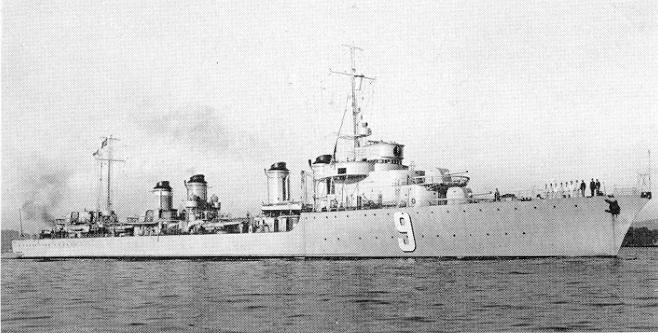
Destroyer Kersaint in 1937 – ONI203 booklet for identification of ships of the French Navy -PD (cc)
Operational career:
They had a relatively short career: The Maille-Breze, used as a minelayer depot ship at anchor in Greenock, exploded in the harbor, March 30, 1940 following a torpedo loading improperly handled which broke off and struck the bridge. The Chevalier Paul, after some service in the Atlantic, was like the others transferred to the Mediterranean. She defended Rayak naval base (Syria), and was sunk by a British raid on June 16, 1941. The four others were scuttled at Toulon on November 27, 1942. Their condition was such that the axis did not even considered salvaging them. They were scrapped after the war.
Specifications
Displacement: 2441 t. standard – 3410 t. Full Load
Dimensions: 129 m long, 11.84 m wide, 4.97 m draft.
Propulsion: 2 propellers, 2 Rake turbines, 6 Yarrow / Penhöet boilers, 64,000 hp. Maximum operational speed 36 knots.
Armour: 20 mm pieces under masks
Armament: 5 pieces of 138 mm model 1927, 4×37 mm AA (2×2), 4×13.2 mm AA (2×2), 7 TLT 550 mm (1×3, 2×2).
Crew: 230

Illustration of the Chevalier Paul in 1941
Le Fantasque class (1933)
These six destroyers, succeeding the long series of “four pipes”, were heavy squadron leaders planned for the new generation of 1935 to 1945, significantly larger, roomier, more powerful and faster, with new 140 mm cal. 45 (1929) semi-auto guns, this time capable of an impressive rate of 12 rounds per minute with a useful range of 20 kilometers. The Fantasque, sometimes also called “class Malin” resumed the previous configuration of torpedo tubes in lateral and axial banks, this time, all triples. Their new turbines and boiler boosters gave them 74,000 hp with an operational cruising speed of 37 knots, easily exceeded in sea trials: The absolute world record, reached by the Terrible, was 45 knots.
The Le Malin, le Terrible, l’Indomptable, l’Audacieux, le Fantasque, le Triomphant (names later used for the 1970s French SSBNs) were launched in 1933-34 and commissioned in 1935-36. The Parsons turbines of some of them had to deplore repeated failures during their career. These destroyers also had a new telemetry equipment, new superstructures, and two raked funnels. They announced the upcoming super-destroyers of the Mogador class. Recognized as the fastest military ships worldwide at their entry into service, being able to run at full load in all weather at 37 knots, they were among the jewels of the fleet.
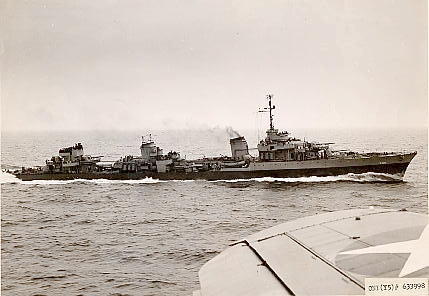
Le Fantasque, US Navy aerial photo 1944 – PD (cc)
Operational career:
Interned in Britain during the “Catapult” operation, the Triomphant became the first destroyer operated by the FNFL in July 1940. She swapped her rear gun for a British model. The Bold was present in Dakar during the British & Free French attack, and retaliated, but was severely damaged by HMS Australia cruiser fire. Repaired, she then went to Bizerte, where she was sunk by an Allied raid in May 1943. The Indomitable had taken refuge in Toulon, only to sank by scuttling in November 1942.
The two others rallied the USA following the Allied landings in North Africa, and were modernized between February 1943 and April 1944. They returned with a powerful American AAA (8 x 40 mm, 20 x 20 mm), radars and various standard equipments of the US navy. Their career was long and active as they were retired from service between 1954 and 1964.
Specifications
Displacement: 2570 t. standard – 3400 t. Full Load
Dimensions: 132.50 m long, 11.98 m wide, 4.30 m draft.
Propulsion: 2 propellers, 2 Parsons / Rateau-Bretagne turbines, 6 Yarrow / Penhöet boilers, 64,000 hp. Maximum operational speed 36 knots.
Armour: 20 mm gun masks
Armament: 5 pieces of 138 mm model 1932, 4×37 mm AA (2×2), 4×13.2 mm AA (2×2), 9 TLT 550 mm (1×3, 2×3).
Crew: 220

Author’s illustration of the Audacieux in June 1940.
Mogador class (1935)
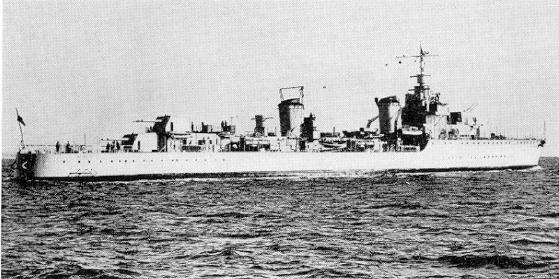
Mogador, stern view – src ONI identification booklet, USN Intelligence.
The last great French squadron destroyers (with the unfinished T47 series), the Mogador and the Volta were in fact only two “prototypes” of a future serie of larger ships. They repeated many of the previous configurations while innovating with two “pseudo-turrets”, in fact paired artillery pieces protected under extended masks opened at the back, comparable to “semi-turrets”. The Mogador were even more powerful and larger than previous destroyers and were to serve as scouts for the Dunkirk and Strasbourg, rather than as squadron leader, which explains a production limited to two units, but also their stronger construction, adapted to the North Atlantic, and much their higher range.
The hull construction involved riveted joints, welds, with 60 kg/m2 enriched steel for the most stressed parts of the structure, and superstructures partly made of duralumin. The new Indret booster boilers claimed 3,500 kilopascals (510 psi), together with state-of-the art Rateau-Bretagne turbines giving a total of 46,000 hp each, allowing a top speed of over 43 knots (trials). Excellent steamers, they were able to easily sustain 34 knots by a gale force 4.
They were also equipped with auxiliary cruise turbines that could be coupled to the central shaft, but this was a failure in practice. Similarly, the design of their propellers was not satisfactory and occasional problems of intense cavitation at high speed. Finally, their rudder was small and especially with a servomotor too low power. De facto, their maneuverability was bad, so much so that the Dunkirks had to restrict their evolutions so that the Mogador could follow them… Finally, the electrical installation inherited from the previous destroyers, and revealed clearly underpowered for the Mogador, whose needs were those of light cruisers…
The “pseudo-turrets” were part of a 1934 electrically powered, gun-mount set. The mounts had not been tested cleanly and were of poor quality. Firing tests proved disastrous. In addition, the turrets were heavy and caused stability issues detrimental as gun platforms. They rolled heavily. As a result of the reports, they were to be completely revised in January 1939, but the war did not allowed it. The 37 mm double AA mounts were of the 1933 model. The gun was a 1925 semi-automatic model using ammunition in racks of 6, giving them a firing ratio of 30 to 40 rounds per minute. A new 37 mm automatic, high range (48 caliber) gun capable of firing 165 rounds per minute was developed for them in 1939 but never installed.
The 13.2 mm Hotchkiss double mounts (450 strokes/min) were designed mainly against strafing low-altitude attacks. Their superior firing arc was mediocre, and their shields were later removed. The anti-surface capability of the Mogador was taken care of, given their use as Dunkirk-class escorts. They received no less than 12 torpedo tubes, all placed on the flanks. This posed stability problems. Torpedoes mod. 1923 DT with alcohol engine had a useful range of 9000 meters at 39 knots. Like previous ships, 16 Guirard ASW deep-charges were stored in stern tunnels, with 16 others in reserve.
They were launched in 1935-36 and accepted in service before the war, in March and April 1939. They were actually assigned to the “Raid Force”, based in Brest. They formed then the 6th division of destroyers. They operated against the German raiders and ensured the protection of the convoys. On 21 November in particular, with the Raid Force, they joined the Hood around Iceland to try to catch the Gneisenau and Scharnhorst.

French destroyer Volta underway off Portsmouth, England (UK), on 8 August 1939 – ONI identification of French ships PD (cc)
Both German ships retreated cautiously using heavy weather to their advantage. They then returned to Brest for a series of modifications, including the addition of a sonar. They were then sent in the Mediterranean before the Italian entered the war. They were based at Mers-el-Kebir during Operation Catapult. The Mogador was hit by a 381 mm projectile in the rear, which detonated her ASW grenades, destroyed the stern and set the decks on fire.
She was stranded and was later declared lost. The Volta had more chance and managed to leave the harbor with Strasbourg. Later the Mogador was salvaged and summarily repaired so as to join Toulon in turn. In November 1942 both ships were scuttled and sank. The Italians salvaged the ships, but repairs never materialized and both units ended broken up after the war.
Characteristics:
Displacement: 3300 t. standard – 4300 t. Full Load
Dimensions: 137.50 m long, 12.57 m wide, 4.74 m draft.
Propulsion: 2 propellers, 2 Parsons / Rateau-Bretagne turbines, 4 Indret boilers, 92,000 hp. Maximum operational speed 39 knots.
Armour: 20 mm pieces under masks
Armament: 8 pieces of 138 mm model 1934 (4×2), 2×37 mm AA (2×1), 4×13.2 mm AA (2×2), 10 TLT 550 mm (2×3, 2×2).
Crew: 236

Author’s illustration of the Mogador in march 1938, in operation on Spanish coast.
Le Hardi class (1939)

The Hardi. As head of a class of 12 new units that were somehow “mogador in reduction”, only the Hardi was in service before the capitulation. The others knew only a brief career without glory. Src ONI203 booklet for identification of ships of the French Navy, PD (cc)
Last “standard” destroyers of the so-called 1500 tons type, the class T47 or “The Hardi” was planned to serve the Dunkirk class and be led by the Mogador type and those who would follow. One of the specifications included the need to sustain 40 knots for a certain time in calm sea and 35 in gale weather. They had been expanded both to accommodate new turbines and boilers and additional oil reserves. Their dimensions and displacement were a leap forward, and this “standard” passed the 1800 tons mark.
In addition to the reinforced hull designed for the North Atlantic, the great novelty was their artillery in double mounts inside “pseudo-turrets” quite similar to those of the Mogador, planned for the new 130 mm gun model. Their AA was also much improved, as well as their rangefinders. But authorization did not arrive until 1938 and in June 1939, they were still in completion. In fact, apart from the Hardi, 7 other units entered service with the French Vichy navy, all based in Toulon where they were scuttled in November 1942. Four others were never completed. In 1943, the Italians salvaged several ships, renamed the FR33 to 37, transferred to Genoa. Their completion to Italian standards was never really completed before the Italian surrender. They were subsequently sunk by the Germans or the allies.
Characteristics:
Displacement: 1770 t. standard – 2577 t. Full Load
Dimensions: 117.20 m long, 11.10 m wide, 4.20 m draft.
Propulsion: 2 propellers, 2 Parsons/Rateau-Bretagne turbines, 4 Sural-Noguet boilers, 58,000 hp. Maximum operational speed 37 knots.
Armour: 20 mm pieces under masks
Armament: 3 pieces of 130 mm model 1936 (3×2), 2×37 mm AA (2×1), 4×13.2 mm AA (2×2), 7 TLT 550 mm (1×3, 2×2).
Crew: 187
La Melpomène class TBs (1935)
France and Italy thought that torpedo boats were still relevant in the Mediterranean, where sea conditions are often milder than in the Atlantic, and shorter ranges are common, allowing ships of smaller radius to operate effectively. Moreover, Washington’s treaty said nothing about these. Below 600 tons, there were less manpower constraints either. As a result, in the beginning of the 1930s the French Admiralty resumed a study of a modern torpedo boat for coastal defense operations and for the open sea. Twelve ships were built, launched in 1935-37 and completed in 1936-38. Their hull was very lightly built, and the heaviness of their armament caused stability problems. Their standard tonnage was 600 tons, but they reached nearly 900 at full load and in designed looked like destroyers in reduction. With a better ASW capability they could he been considered as destroyer escorts.
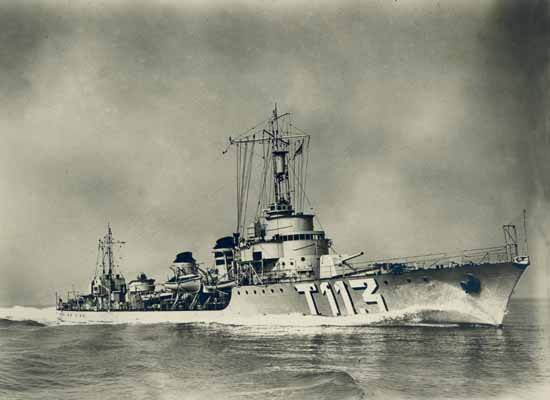
Branlebas, La Melpomène class. Private Coll. Alain V.
When the armistice came, they were paradoxically assigned to the Atlantic. Many sailed to British ports where they were interned. The Branlebas, for example, sailed again under British flag but capsized in December 1940. Bouclier was ceded to the Poles, before returning to the FNFL, while Melpomene served under the Free Duch Navy flag and was then donated to the FNFL. The three ships interned in Bizerte were finally captured in December 1942 (the only French ships in good condition to ever fall into axis hands). They passed and operated for a short time under the Italian flag (Fr41, 42 and 43) then Germans after their capitulation and capture (Ta9, 10 and 11).
They were all sunk in operations. The last three French units were in Toulon. They were scuttled in December 1942, then two were salvaged, repaired, and served under the Italian flag (Fr44 and Fr45) then also German (Ta12, Ta13). They were probably sunk by Allied Air raids in 1944. Five of these ships survived the war and were scrapped soon after.
Another class of torpedo boats was planned to succeed them, the “Le Fier”. They were considerably heavier and stronger and almost reached the tonnage of standard destroyers. Of the three series only the first was launched in time (of 8 units) started in 1939. The admiralty planned their completion for 1942, under Vichy control, but they were all captured after the invasion of the “free zone” by the Germans, renamed Ta1 to Ta6. However completion work dragged on for lack of time, equipment, personnel and sabotage. Instead, they ended broken up after the war.
Characteristics:
Displacement: 685 t. standard – 985 t. Full Load
Dimensions: 80.70 m long, 7.96 m wide, 3 m draft.
Propulsion: 2 propellers, 2 Turbine turbines, 4 Indret boilers, 22,000 hp. Maximum operating speed 34.7 knots.
Armour: none
Armament: 2 pieces of 100 mm model 1932, 2×37 mm AA, 4×13.2 mm AA (2×2), 2 TLT 550 mm (1×2).
Crew: 92

Iphigénie in november 1942.
Sources/ read More
French naval blueprints database
Conways all the worlds fighting ships 1906-21 and 1922-46.



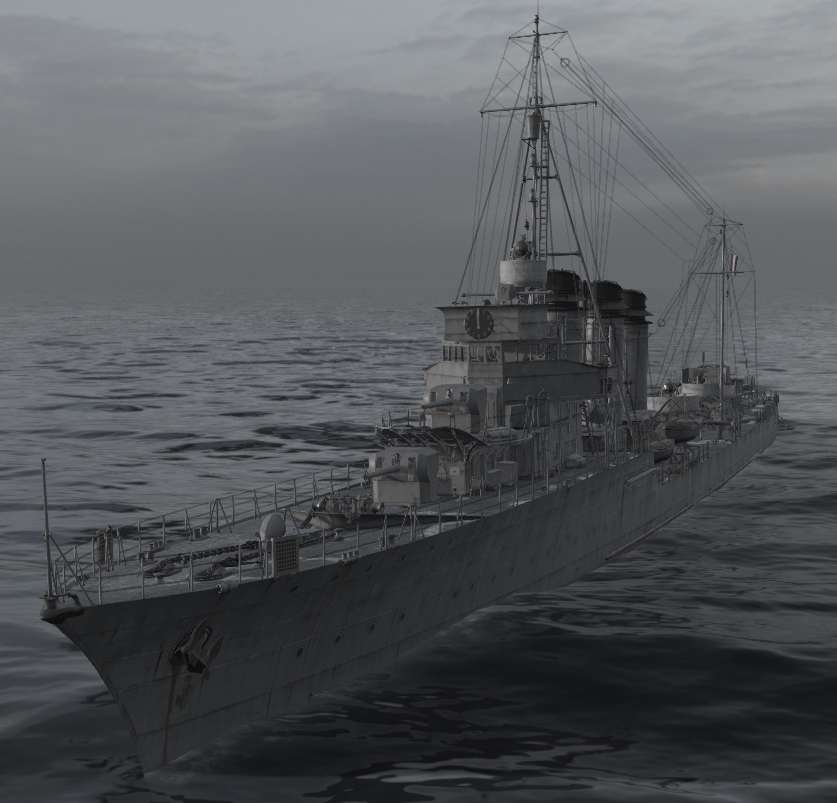
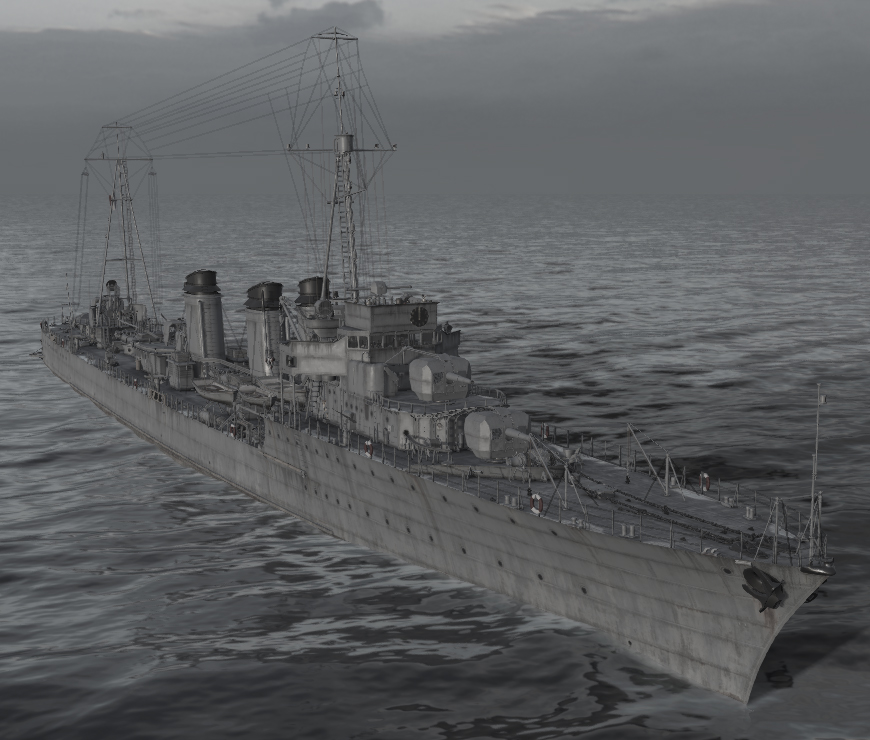
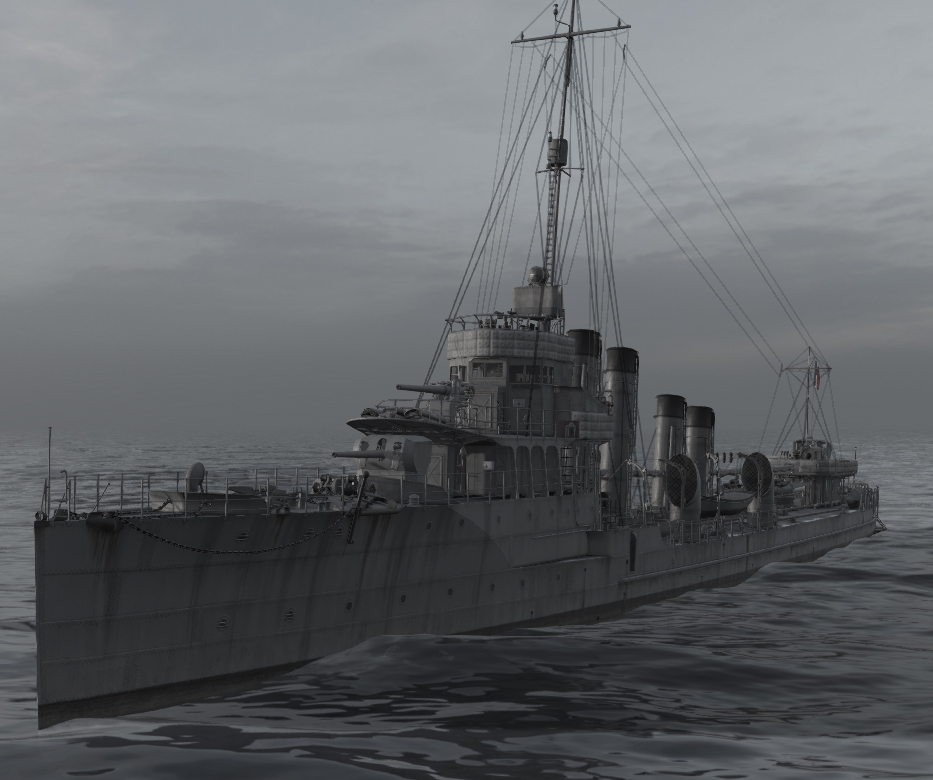
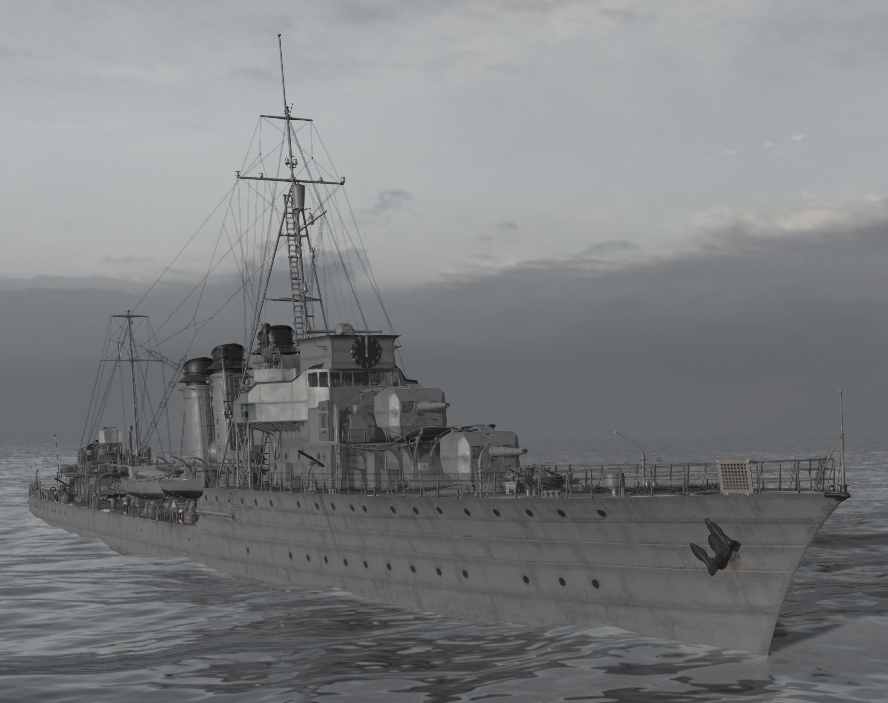
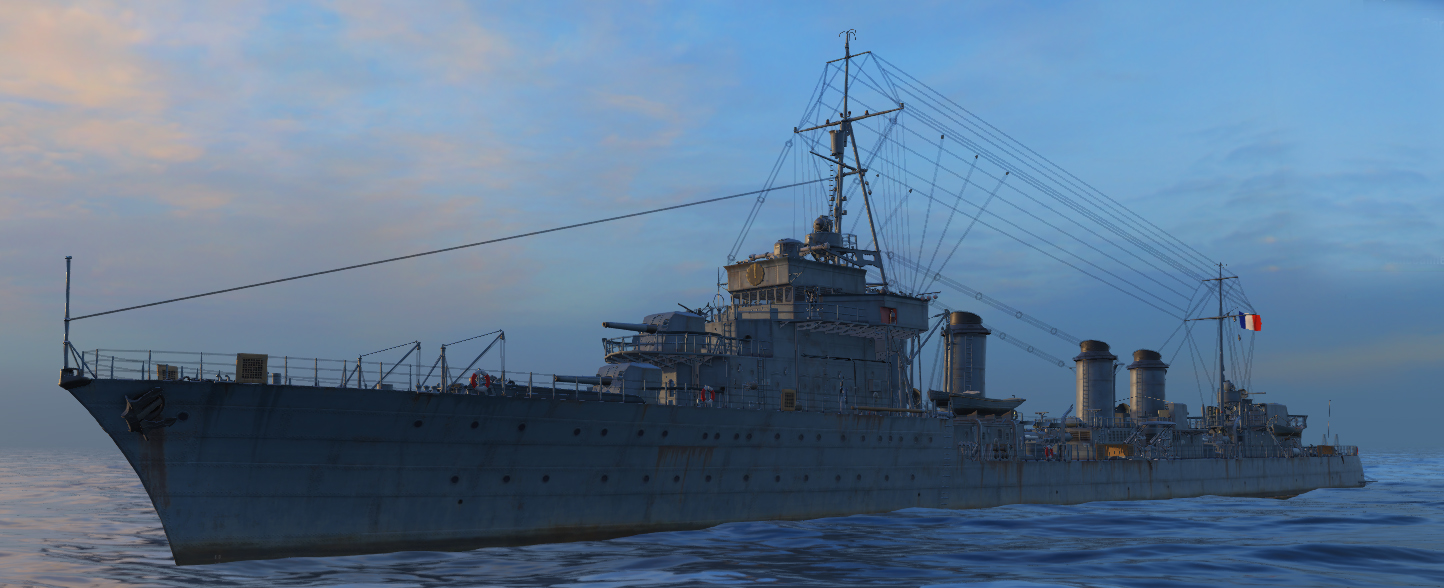
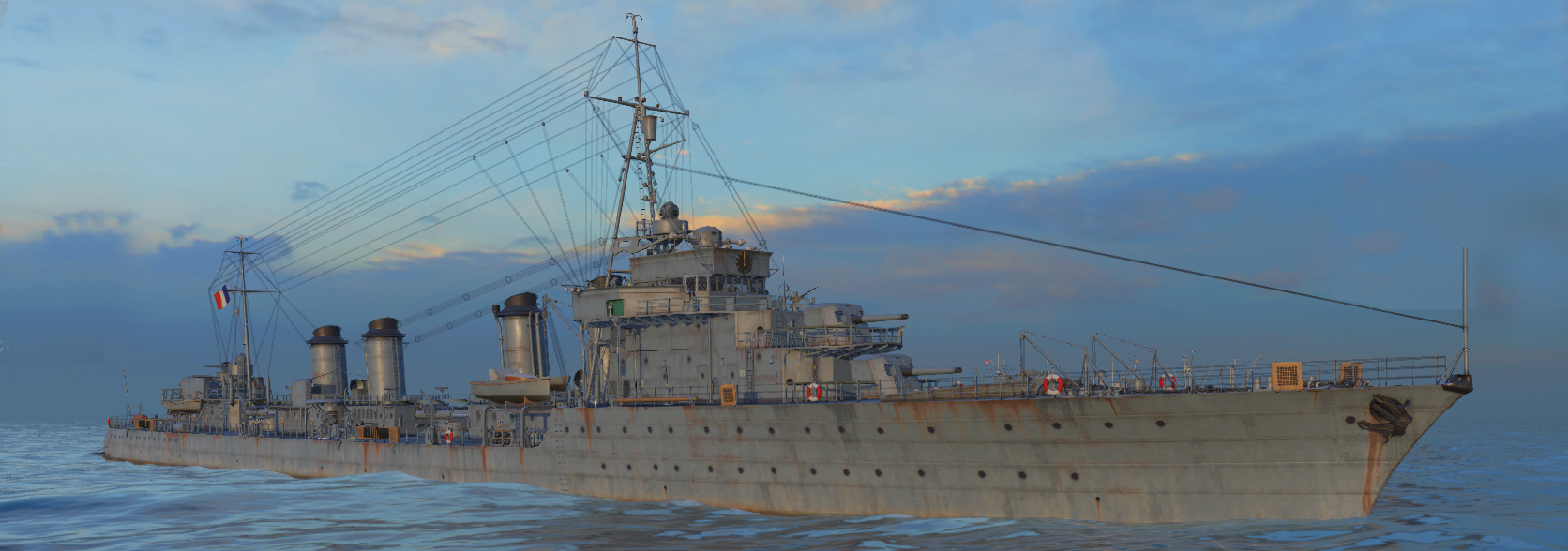
 Latest Facebook Entry -
Latest Facebook Entry -  X(Tweeter) Naval Encyclopedia's deck archive
X(Tweeter) Naval Encyclopedia's deck archive Instagram (@navalencyc)
Instagram (@navalencyc)





 French Navy
French Navy Royal Navy
Royal Navy Russian Navy
Russian Navy Armada Espanola
Armada Espanola Austrian Navy
Austrian Navy K.u.K. Kriegsmarine
K.u.K. Kriegsmarine Dansk Marine
Dansk Marine Nautiko Hellenon
Nautiko Hellenon Koninklije Marine 1870
Koninklije Marine 1870 Marinha do Brasil
Marinha do Brasil Osmanlı Donanması
Osmanlı Donanması Marina Do Peru
Marina Do Peru Marinha do Portugal
Marinha do Portugal Regia Marina 1870
Regia Marina 1870 Nihhon Kaigun 1870
Nihhon Kaigun 1870 Preußische Marine 1870
Preußische Marine 1870 Russkiy Flot 1870
Russkiy Flot 1870 Svenska marinen
Svenska marinen Søværnet
Søværnet Union Navy
Union Navy Confederate Navy
Confederate Navy Armada de Argentina
Armada de Argentina Imperial Chinese Navy
Imperial Chinese Navy Marinha do Portugal
Marinha do Portugal Mexico
Mexico Kaiserliche Marine
Kaiserliche Marine 1898 US Navy
1898 US Navy Sovietskiy Flot
Sovietskiy Flot Royal Canadian Navy
Royal Canadian Navy Royal Australian Navy
Royal Australian Navy RNZN Fleet
RNZN Fleet Chinese Navy 1937
Chinese Navy 1937 Kriegsmarine
Kriegsmarine Chilean Navy
Chilean Navy Danish Navy
Danish Navy Finnish Navy
Finnish Navy Hellenic Navy
Hellenic Navy Polish Navy
Polish Navy Romanian Navy
Romanian Navy Turkish Navy
Turkish Navy Royal Yugoslav Navy
Royal Yugoslav Navy Royal Thai Navy
Royal Thai Navy Minor Navies
Minor Navies Albania
Albania Austria
Austria Belgium
Belgium Columbia
Columbia Costa Rica
Costa Rica Cuba
Cuba Czechoslovakia
Czechoslovakia Dominican Republic
Dominican Republic Haiti
Haiti Hungary
Hungary Honduras
Honduras Estonia
Estonia Iceland
Iceland Eire
Eire Equador
Equador Iran
Iran Iraq
Iraq Latvia
Latvia Liberia
Liberia Lithuania
Lithuania Mandchukuo
Mandchukuo Morocco
Morocco Nicaragua
Nicaragua Persia
Persia San Salvador
San Salvador Sarawak
Sarawak Uruguay
Uruguay Venezuela
Venezuela Zanzibar
Zanzibar Warsaw Pact Navies
Warsaw Pact Navies Bulgaria
Bulgaria Hungary
Hungary

 Bundesmarine
Bundesmarine Dutch Navy
Dutch Navy Hellenic Navy
Hellenic Navy Marina Militare
Marina Militare Yugoslav Navy
Yugoslav Navy Chinese Navy
Chinese Navy Indian Navy
Indian Navy Indonesian Navy
Indonesian Navy JMSDF
JMSDF North Korean Navy
North Korean Navy Pakistani Navy
Pakistani Navy Philippines Navy
Philippines Navy ROKN
ROKN Rep. of Singapore Navy
Rep. of Singapore Navy Taiwanese Navy
Taiwanese Navy IDF Navy
IDF Navy Saudi Navy
Saudi Navy Royal New Zealand Navy
Royal New Zealand Navy Egyptian Navy
Egyptian Navy South African Navy
South African Navy






























 Ukrainian Navy
Ukrainian Navy dbodesign
dbodesign